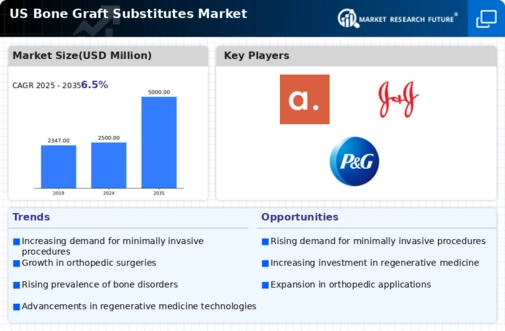Surge in Sports Injuries
The rising incidence of sports-related injuries is another critical factor propelling the bone graft-substitutes market. With an increasing number of individuals participating in various sports and physical activities, the occurrence of fractures and soft tissue injuries has surged. According to recent data, sports injuries account for nearly 20% of all injuries in the US, necessitating effective treatment options. Bone graft substitutes play a vital role in the surgical repair of these injuries, promoting faster recovery and improved outcomes. As the demand for sports medicine continues to grow, the bone graft-substitutes market is poised to benefit from this trend, with an anticipated market value reaching $3 billion by 2027.
Advancements in Biomaterials
Innovations in biomaterials are significantly influencing the bone graft-substitutes market. The development of synthetic and natural materials that mimic the properties of bone has opened new avenues for effective treatments. For instance, bioactive glass and calcium phosphate ceramics are gaining traction due to their osteoconductive properties, which enhance bone regeneration. These advancements not only improve patient outcomes but also expand the range of applications for bone graft substitutes. As research continues to evolve, the market is likely to witness a surge in product offerings, catering to diverse surgical needs. This trend is expected to contribute to a robust growth trajectory, with the market projected to reach $2.5 billion by 2026.
Growing Awareness and Education
Increasing awareness and education regarding bone health and treatment options are pivotal drivers for the bone graft-substitutes market. Healthcare professionals and patients are becoming more informed about the benefits of bone graft substitutes in promoting healing and recovery. Educational initiatives and campaigns aimed at highlighting the importance of bone health are contributing to a more proactive approach to treatment. As patients seek out advanced solutions for bone repair, the demand for bone graft substitutes is expected to rise. This heightened awareness is likely to translate into increased market penetration, with the bone graft-substitutes market anticipated to reach $4 billion by 2028.
Rising Incidence of Bone Disorders
The increasing prevalence of bone disorders, such as osteoporosis and osteoarthritis, is a primary driver for the bone graft-substitutes market. In the US, it is estimated that around 10 million individuals suffer from osteoporosis, leading to a heightened demand for effective treatment options. This growing patient population necessitates innovative solutions, including bone graft substitutes, to facilitate bone healing and regeneration. Furthermore, the aging population, which is more susceptible to fractures and bone-related ailments, contributes to the market's expansion. As healthcare providers seek to address these challenges, the bone graft-substitutes market is likely to experience significant growth, with projections indicating a compound annual growth rate (CAGR) of approximately 6% over the next several years.
Increased Focus on Regenerative Medicine
The growing emphasis on regenerative medicine is reshaping the landscape of the bone graft-substitutes market. As healthcare providers and researchers explore innovative approaches to tissue repair and regeneration, the demand for effective bone graft substitutes is on the rise. Regenerative medicine aims to restore the function of damaged tissues, and bone graft substitutes are integral to this process. The US market is witnessing a shift towards personalized medicine, where treatments are tailored to individual patient needs. This trend is likely to drive investments in research and development, fostering the introduction of novel products in the bone graft-substitutes market. The market is projected to grow at a CAGR of 7% over the next five years.














Leave a Comment